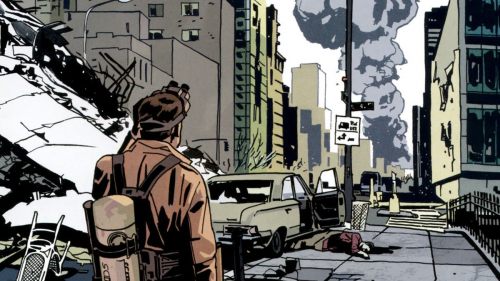A WRINKLE IN TIME REVIEW: A Film Of Solid Sincerity
You might think that in a world in which a movie about a woman falling in love with a fish-man wins the Oscar for Best Picture, there’s no image left in the cinema that can truly mystify you. You can think that, but you’re most certainly wrong. I offer up a 20-foot-tall Oprah Winfrey dispensing New Age advice to a young girl in the middle of a bucolic field of swaying grass. A Wrinkle in Time, Ava DuVernay’s highly anticipated theatrical follow-up to Selma, accepts your challenge.
Despite the way that I’ve somewhat glibly described this scene, A Wrinkle in Time is not a film to be scoffed at, because it is so committed to its magical, mystical tone at every turn. Meg, the movie’s precocious lead (played by 14-year-old Storm Reid) learns a variety of life lessons, but the most vital one for her is to believe in herself and to embrace her quirks. It’s a lesson that the picture itself takes to heart. How many times is a moment of wonder or brazen oddity undercut by a quip or a self-conscious wink in a modern movie? This is not to say that the current cinema is devoid of heart, because there are countless movies that have touched me and audiences around the world in the last 20 years. It’s more that when contemporary filmmakers know they’re asking a lot of the customer, they use humor to ease anxiety. “Yes, we know the thing you’re watching is weird—a giant monster, a spaceship, a man flying around Malibu in a robot suit, etc.—we’re in on it. We get it.” The Marvel and Pixar franchises have masterfully wielded the tool those of us who were nerds in school dutifully weaponized: the well-placed one-liner as defense against social anxiety. A Wrinkle in Time is often funny. It’s contains a playful spirit that will endear it to parents and children alike, but it’s not going to sacrifice pathos for a gag. It’s like an earnest, forceful hug from an aunt or uncle that they refuse to let go of. It eventually stops being uncomfortable, because you come to realize they really, really mean it.
A Wrinkle in Time is based on Madeline L’Engle’s 1962 book of the same name, which carried a certain amount of Christian symbolism throughout. DuVernay’s film is a bit more agnostic about the existence of a higher power, though there isn’t much of a greater spiritual authority than Oprah. Winfrey (whose grace and power made me think she was channeling Michelle Obama the whole time), Reese Witherspoon, and Mindy Kaling play Mrs. Which, Mrs. Whatsit, and Mrs. Who respectively—celestial beings of light charged with protecting all that’s good from IT, the embodiment of everything evil. Meg, her brother Charles Wallace (Deric McCabe), and potential love interest Calvin (Levi Miller) are enlisted into this eternal struggle while simultaneously looking for Meg and Charles Wallace’s missing father (Chris Pine)—a scientist who disappeared attempting to prove that time and space can be “wrinkled” and that humanity can travel great distances with the power of the mind.
The events of the film exist under a hazy dream logic, in the grand tradition of children’s fantasy tales like The Neverending Story or Labyrinth. One either chooses to accept the explicit, but far-fetched logic or one does not. Reese Witherspoon can turn into a flying lettuce creature, because of course she can. The source of all that is hateful and grotesque about life on Earth can be traced back to a black cloud floating in space. The power to make the world a better place is buried inside you if you just believe. Characters often speak in unnatural ways, particularly Calvin, who is saddled with the job of flashing his doe-eyes and remarking on the magnificence of Meg—common in kids’ fantasy, but refreshing when it’s the girl who’s the protagonist and the object of affection for her cleverness. The stilted, ethereal quality of the film grates if you are unwilling or incapable of meeting the story halfway. As Meg lets her guard down and grows in confidence, so does the movie itself. She’s sullen and fixated on her absentee father, but the adventure emboldens her. Similarly, A Wrinkle in Time settles into itself as Meg, Charles Wallace, Calvin travel to the planet Camazotz, where IT resides and dad is being held captive.
The movie A Wrinkle in Time most resembles from a thematic standpoint is, oddly enough, IT—the Stephen King adaptation from last year. In both films, the purity of love and the bonds of childhood friendship lift a group of misfits out of danger. Where they differ is in Wrinkle’s humanity. IT was a movie set in the 1980s that employed all the tricks of 2017 and was nostalgic in the way that so much of our entertainment is at this moment. A Wrinkle in Time is set in our present, but has the uncontaminated sincerity of films from decades past. Its gleaming, multiracial cast and propensity for philosophizing lack even a trace of irony. In the wake of Get Out and Black Panther, A Wrinkle in Time completes a trilogy of transcendent black filmmaking. Get Out examines the painful past. Black Panther shows what we are and can be. A Wrinkle in Time looks at what’s next through the eyes of children with open hearts and curious minds. It taps into a sentimentality and a warmth in movies that is necessary and overdue. DuVernay has created a world that’s pure magic and welcomes you in without judgment. It simplifies our complex existence into a universal truth: that we’re better off together—you, me, and 20-foot Oprah.



